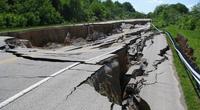-
Sea level rise threatens California coastal infrastructure
Officials in Humboldt County, California are preparing for sea level rise, which experts say could threaten utilities and U.S. highway 101. The National Research Councilwarns that California, Oregon, and Washington could experience twelve inches of sea level rise by 2050 and thirty-six inches by 2100. Sea level on Humboldt Bay has increased by eighteen inches over the past century due to increasing tide elevation and subsidence. Gas, electrical, and water transmission lines are all buried in the farmlands behind dikes that fortify the shoreline.
-
-
Generating fuel from sunlight
Researchers have made significant progress towards developing a process of Artificial Photosynthesis (AP) that could replace the use of fossil fuels in the future. AP is the industrial process of preparing fuels and chemicals from nothing more than carbon dioxide, water and sunlight. It is a vital process that would be the foundation of a world that would no longer need fossil fuels.
-
-
Russian government hackers insert malware in U.S. critical infrastructure control software
Investigators have uncovered a Trojan Horse named BlackEnergy in the software that runs much of the U.S. critical infrastructure. In a worst case scenario, the malware could shut down oil and gas pipelines, power transmission grids, water distribution and filtration systems, and wind turbines, causing an economic catastrophe. Some industry insiders learned of the intrusion last week via a DHS alert bulletin issued by the agency’s Industrial Control Systems Cyber Emergency Response Team(ICS-CERT). The BlackEnergy penetration had recently been detected by several companies. Experts say Russia has placed the malware in key U.S. systems as a threat or a deterrent to a U.S. cyberattack on Russian systems – mutual assured destruction from a cold war-era playbook.
-
-
As drought continues, more Californians turn to greywater
California’s rainy season tends to run from October to late March, but for the third year in a row rain has been relatively absent, meaning that the state is currently suffering from a severe, unprecedented drought. With increasing water rates, a growing number of homeowners in Southern California are relying on greywater systems to support their landscapes and toilet flushing. “If the drought continues, honestly, I could see all new construction will have greywater systems of some kind because it really doesn’t make sense to put usable water in the sewer system,” says one expert.
-
-
State, federal role in electric utilities’ labor issues should be reexamined: Study
Power outages have never been more costly. Electricity is critical to communication, transportation, commerce and national security systems, and wide-spread or prolonged outages have the potential to threaten public safety and cause millions, even billions, of dollars in damages. This is why it may be time to re-examine the role of public utility commissions and the effect of the National Labor Relations Act in labor disputes regarding electric utilities, a new study suggests.
-
-
NASA facilities across U.S. vulnerable to climate change
The National Aeronautics and Space Administration (NASA) has been at the forefront of climate science, launching satellites that take the pulse of Earth’s land, oceans, and atmospheric systems, gathering data on climate, weather, and natural hazards. The agency, however, is itself increasingly vulnerable to the effects of a changing climate. Hurricane Isabel partially flooded the Langley Research Center in Virginia in 2003; Hurricane Frances damaged the Kennedy Space Center in Florida in 2004; and Hurricane Katrina damaged buildings at the Stennis Space Center in Mississippi in 2005, among recent incidents. Other facilities have been damaged or threatened by tornadoes and wildfires.
-
-
Harnessing artificial intelligence to search for new Ebola treatments
The University of Toronto, Chematria, and IBM are combining forces in a quest to find new treatments for the Ebola virus. Using a virtual research technology invented by Chematria, a startup housed at U of T’s Impact Center, the team will use software that learns and thinks like a human chemist to search for new medicines. Running on Canada’s most powerful supercomputer, the effort will simulate and analyze the effectiveness of millions of hypothetical drugs in just a matter of weeks.
-
-
Standardizing small, self-sustaining electric microgrids
When Department of Energy and Oak Ridge National Laboratory researchers talk about “islanding,” or isolating, from the grid, they are discussing a fundamental benefit of microgrids — small systems powered by renewables and energy storage devices. The benefit is that microgrids can disconnect from larger utility grids and continue to provide power locally.
-
-
Hungarian red mud spill did little long-term damage

The aftereffects of the 2010 red mud spill that threatened to poison great swathes of the Hungarian countryside have turned out to be far less harmful than scientists originally feared. The disaster happened when weeks of heavy rain caused a dam to collapse at a containment facility in Ajka in Western Hungary. It released around a million cubic meters of toxic sludge into the Torna-Marcal river system, onto the Hungarian plain and ultimately into the Danube. The mud, a byproduct of refining aluminum from bauxite ore, was dangerously alkaline, extremely salty and contained potentially toxic metals like chromium and vanadium.
-
-
Lights out: Experts say instability of world’s power supplies must be urgently addressed
A new study reveals the urgent need to address instabilities in the supply of electrical power to counteract an increase in the frequency and severity of urban blackouts. The work builds on previous studies which examined a sharp increase in electrical usage over recent years, and warned the world to prepare for the prospect of coping without electricity as instances of complete power failure become increasingly common.
-
-
Major American cities manage water supply better
In an effort to address environmental factors, population growth, and technological factors, many American cities are taking steps to practice better water conservation efforts, after decades of largely ignoring steps that could be taken. These practices have brought average water use per person each day from fifty-five gallons to something closer at times to thirty to thirty-five gallons.
-
-
A major cyberattack causing widespread harm to national security is imminent: Experts

A new report found that more than 60 percent of the roughly 1,600 computer and Internet experts surveyed on the future of cyberattacks believe a nationwide cyberattack is imminent. They did so in response to the question: “By 2025, will a major cyberattack have caused widespread harm to a nation’s security and capacity to defend itself and its people?” The experts also warn about the risks to privacy which will accompany a growing focus on cybersecurity.
-
-
Coastal towns build resilience to prepare for future storms
Sea Bright, New Jersey is one of several communities affected by Superstorm Sandy which is actively building resiliency against the next major storm. The town, set on a narrow strip of sand between the Atlantic Ocean and the Shrewsbury River, frequently floods, and during Sandy, its entire downtown business district was damaged, as were 75 percent of the town’s homes.
-
-
Upgrading infrastructure could reduce future flood damage

From 1980 to 2007, about 90 percent of all global disasters were caused by flooding either by rain, tsunami, hurricane, or some other natural event. At the same time, the American Society of Civil Engineer’s 2013 Report Card for America’s Infrastructure gave the country a dismal D+. The group said $3.6 trillion was needed by 2020 to address the most serious problems. In Colorado, the report card says, 70 percent of major roads are poor or mediocre and 566 bridges are structurally deficient. A new study argues that the severe flooding that devastated a wide swath of Colorado last year might have been less destructive if the bridges, roads, and other infrastructure had been upgraded or modernized.
-
-
Texas acts to reduce number of man-made earthquakes
The number of disposal wells in Texas has surged along with the number of drilling projects. Texas has more than 3,600 active commercial disposal wells. In 2013, the Railroad Commission approved 668 disposal well permits, twice the number of approvals in 2009. The growing number of disposal wells corresponds with an increase in earthquakes in communities where such seismic activity rarely existed.Officials in Texas have now taken steps to reduce the number of earthquakes caused by wells drilled for the disposal of oilfield waste.
-
More headlines
The long view
Helping Strengthen America’s Critical Infrastructure
By Corinne Dionisio
Everyday life depends on a robust infrastructure network that provides access to running water, communications technology and electricity, among other basic necessities. The experts who keep our national infrastructure secure and resilient also need a strong network to share their knowledge and train the next generation of professionals capable of solving complex infrastructure challenges.
AI and the Future of the U.S. Electric Grid
By Doug Irving
Despite its age, the U.S. electric grid remains one of the great workhorses of modern life. Whether it can maintain that performance over the next few years may determine how well the U.S. competes in an AI-driven world.
Using Liquid Air for Grid-Scale Energy Storage
By Nancy W. Stauffer
New research finds liquid air energy storage could be the lowest-cost option for ensuring a continuous power supply on a future grid dominated by carbon-free but intermittent sources of electricity.
Enhanced Geothermal Systems: A Promising Source of Round-the-Clock Energy
By Julie Bobyock and Christina Procopiou
With its capacity to provide 24/7 power, many are warming up to the prospect of geothermal energy. Scientists are currently working to advance human-made reservoirs in Earth’s deep subsurface to stimulate the activity that exists within natural geothermal systems.
Experts Discuss Geothermal Potential
By Graeme Beardsmore and Rachel Webster, University of Melbourne
Geothermal energy harnesses the heat from within Earth—the term comes from the Greek words geo (earth) and therme (heat). It is an energy source that has the potential to power all our energy needs for billions of years.
